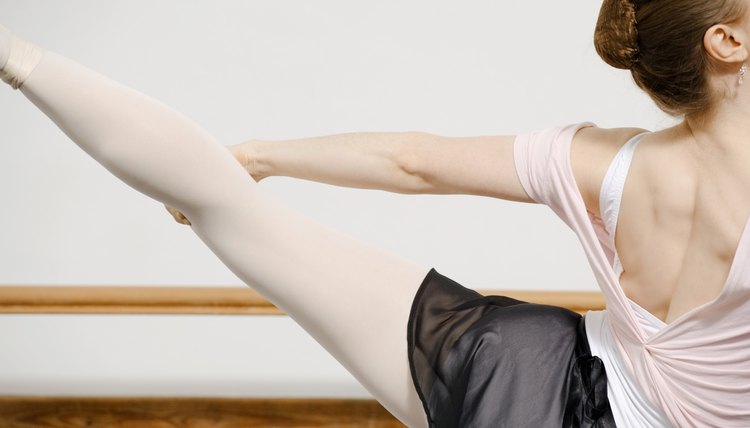Do You Need Strong Hip Flexors for Ballet?

Ballet, with its graceful leaps and turns, its spectacular rounded and angled arms and legs, is really about the hips. The core of the body provides the strength for perfect pirouettes and soaring tour jetés. Hip flexors, the muscles that control sitting, bending, leg lifts, turning and turnout at the hip, have to be balanced -- strong and flexible -- for a ballet dancer to move well and to avoid injury.
Hip Flexors
The hip flexors are a group of muscles running from your lower back to the front of your thigh that let you bend to sit and lift your leg to the front. The main muscles of the flexor group are the iliopsoas -- the psoas major, psoas minor and the iliacus -- and the rectus femoris, part of the quads on the front of the upper thigh. Most people have a problem with shortened hip flexors, the result of too much sitting. The remedy for that is stretching. But ballet dancers need strong and flexible hip flexors to help control the ascent and descent of the leg and to maintain a stable turnout from the hips to the feet. The Rudolf Nureyev Foundation Medical Website recommends exercise to strengthen the iliopsoas and other muscles that control hip flexion to improve turnout.
Challenges to Hip Flexors
Ballet is both a sustained and an explosive activity. Kicks, leaps, arabesques, hops, pliés, fouettés and intricate footwork all make demands on the hip flexors. Weak hip flexors don't adequately support those strenuous moves. But UK athletics coach Brian Mackenzie notes that hip flexors are often overlooked in strength training because there are few specific exercises to target them. Hamstrings, quads and glutes get the attention and, when the flexors are considered, it is typically to stretch them. Stretching is critical in ballet because tight hip flexors can stress the ankle joint and prevent correct position when en pointe, according to Pointe Magazine. The American Council on Exercise adds that stretching counters long periods of sitting that shorten and tighten the muscles on the front of the hip; this tightening can result in strains and tears.
Hip Flexor Strengthening Exercises
Cross-training can strengthen the hip flexors. Body weight supplies resistance to work the hip flexors when you do incline situps and hanging leg raises -- flexing and raising the knees together while hanging from a bar. Reclined leg raises will also challenge the hip flexors as you lie on a bench or mat, engage the abdominals and bend the knees, bringing the thighs to the chest with the legs and feet together. For variety and to work even more muscles, try situps using a stability ball. The ball provides a strong core workout, and the hip movement focuses on the flexors.
Ballet Stretching Exercise
You need strong and supple hip flexors to point those toes to the rafters, and that means stretching as well as strengthening. An exercise recommended by the American Ballet Theatre National Training Curriculum is designed to improve rotation and increase range of motion in the hips by several degrees. Kneel down with a pillow under your left knee and then lunge forward with the right leg so the knee forms a 90-degree angle. Keep your hips squared and don't try to turn out. Tuck the tailbone under, place both hands on your right knee and gently push into the right leg until you feel the stretch in your left hip. Repeat three or four times and then switch to the other side.
References
- Pointe Magazine: Your Best Body: Bad Feet?
- BrianMac: Hip Flexors - The Most Underdeveloped Muscle Group in Strength Training
- American Council on Exercise: Why Do Muscles Tighten Up?
- Harvard Health Publications: Knees and Hips: A Troubleshooting Guide to Knee and Hip Pain
- Rudolf Nureyev Foundation Medical Website: Anterior Hip Impingement Syndrome in Dancers:
- Dance Spirit magazine: The Truth About Turnout
Writer Bio
Benna Crawford has been a journalist and New York-based writer since 1997. Her work has appeared in USA Today, the San Francisco Chronicle, The New York Times, and in professional journals and trade publications. Crawford has a degree in theater, is a certified Prana Yoga instructor, and writes about fitness, performing and decorative arts, culture, sports, business and education .
